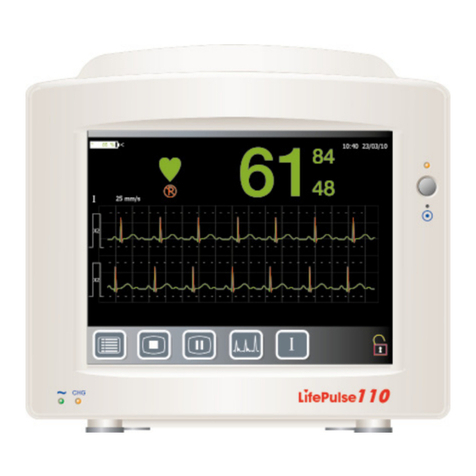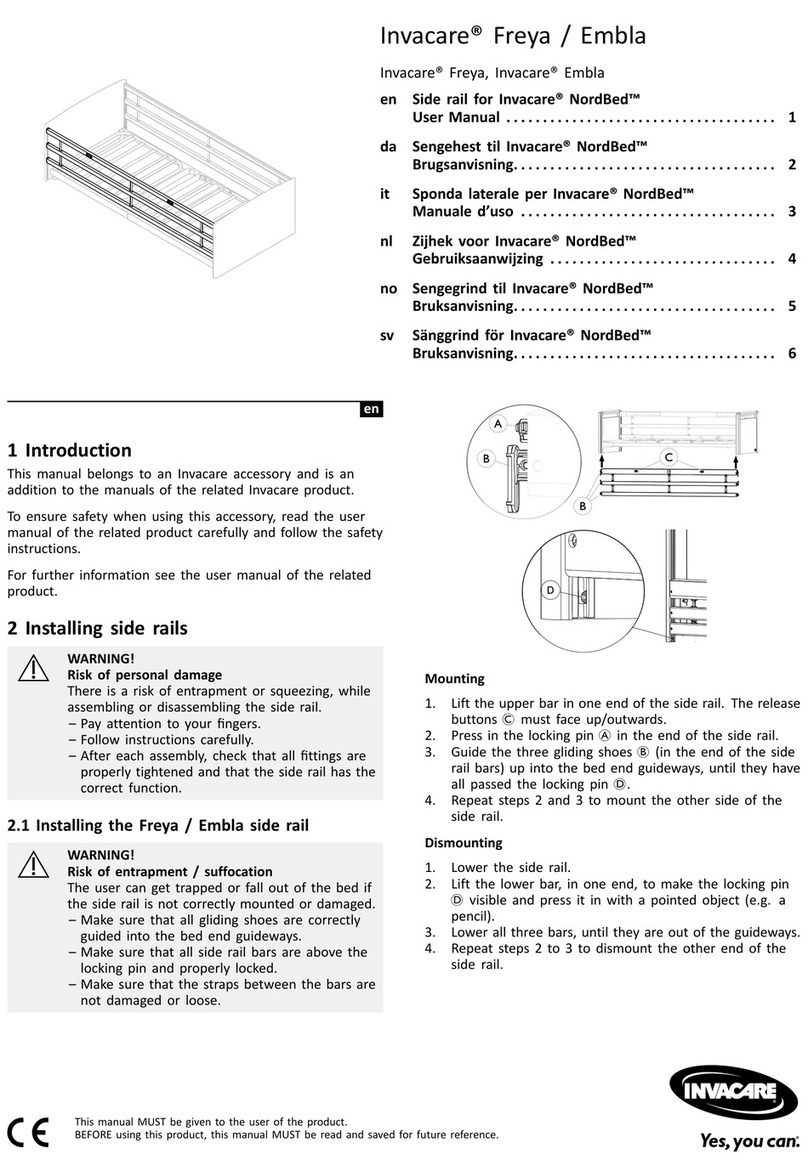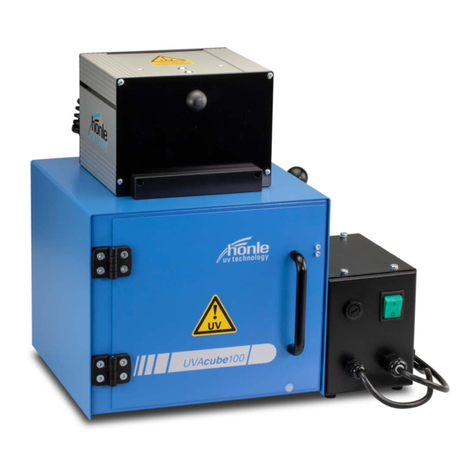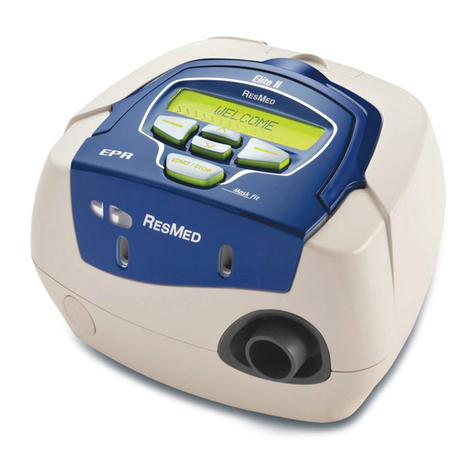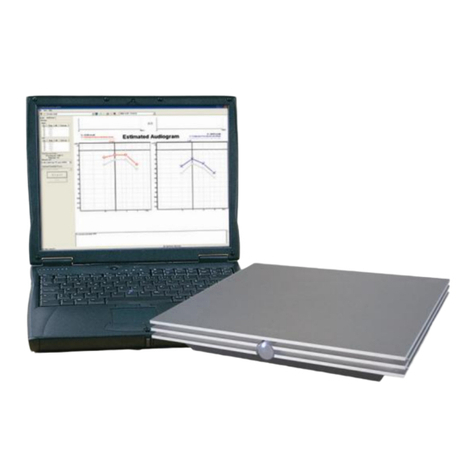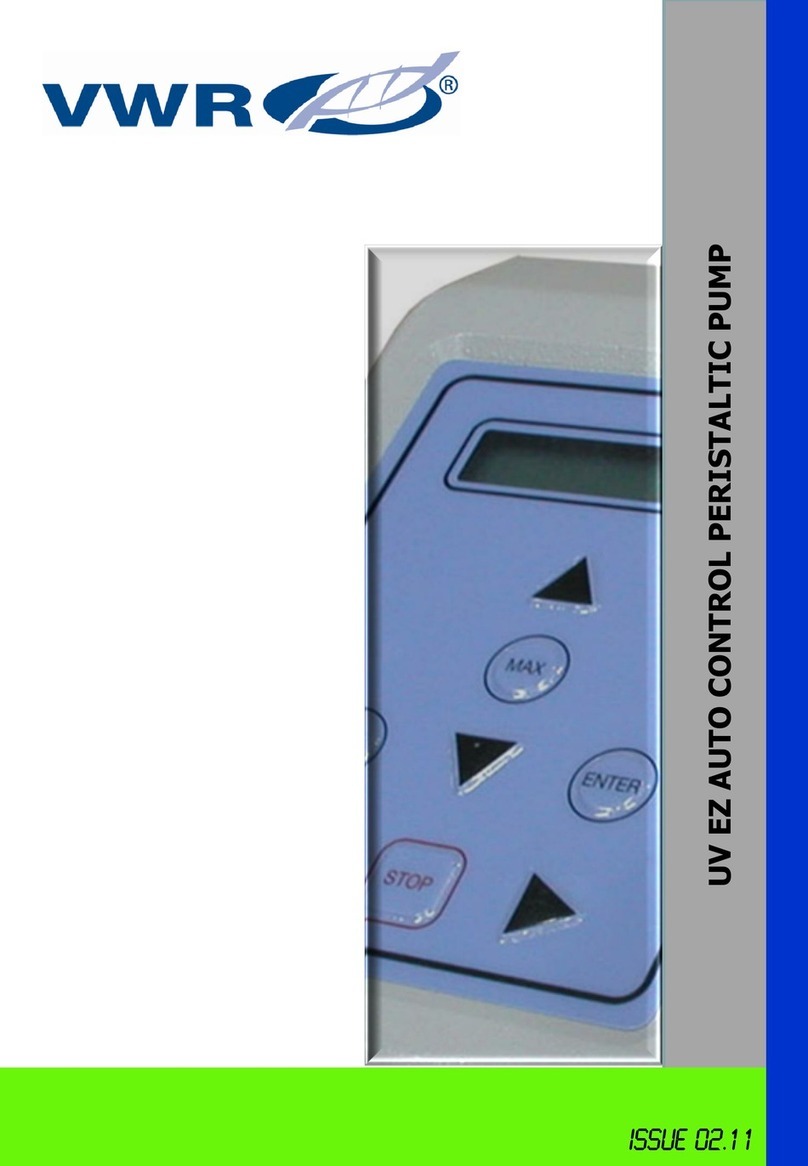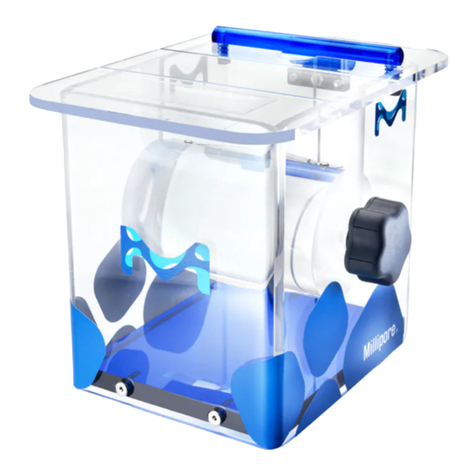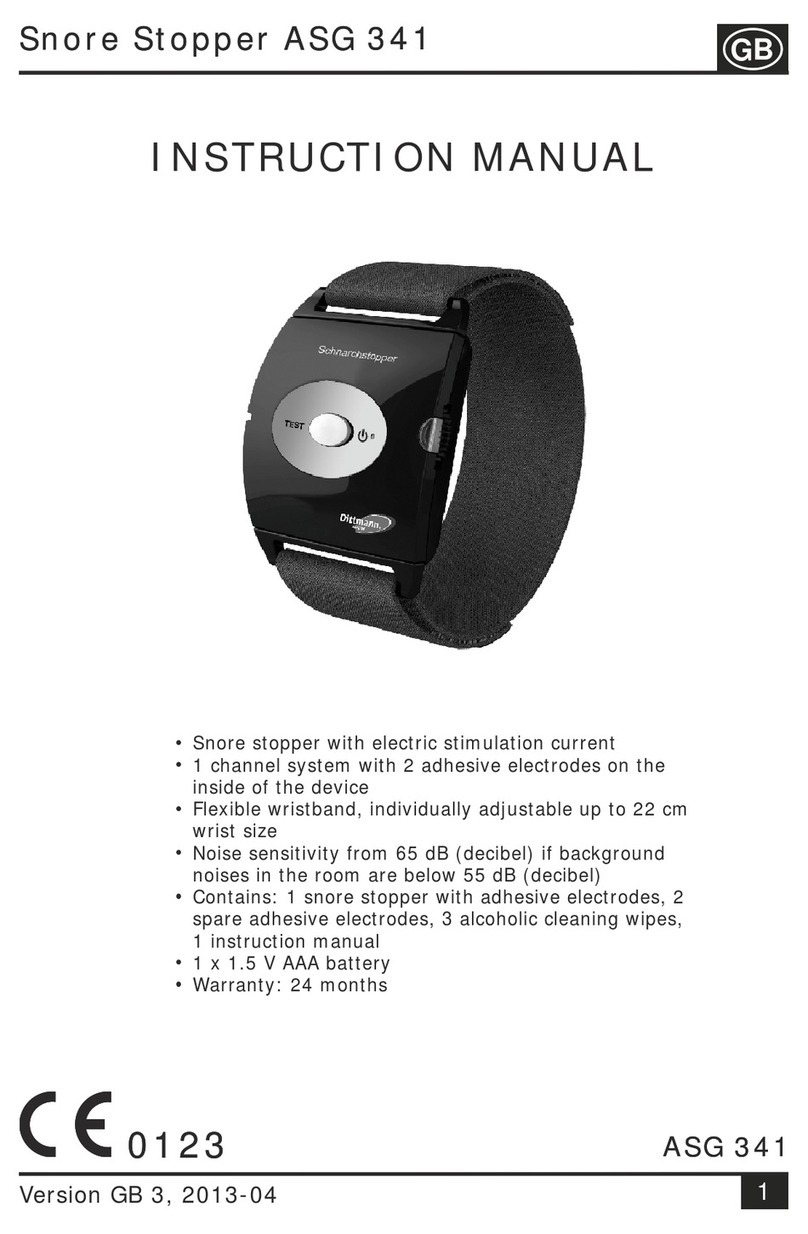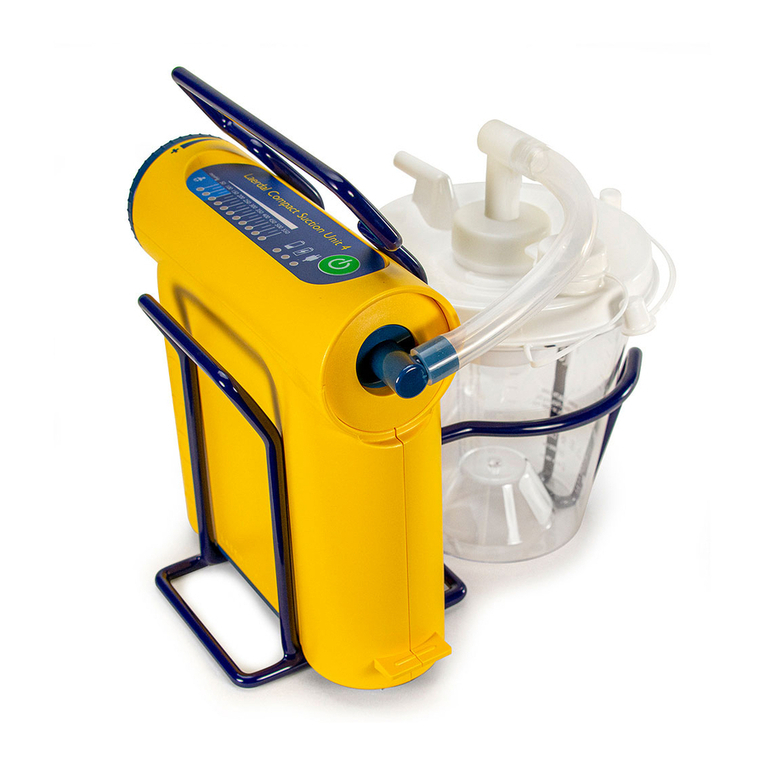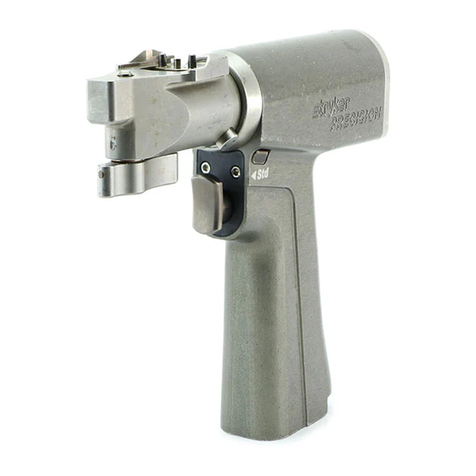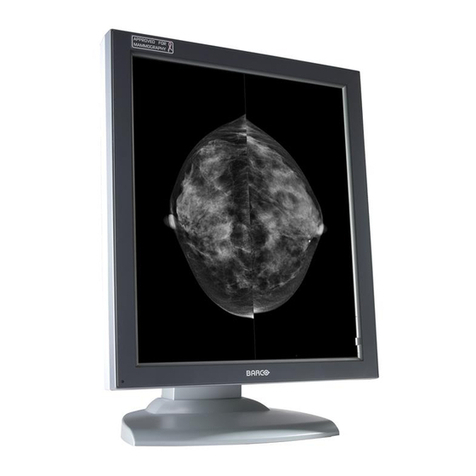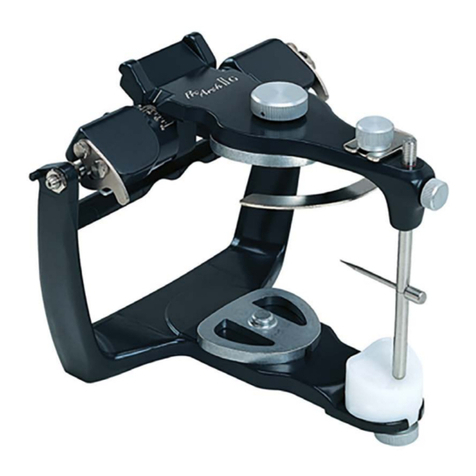Jedmed MACHIDA User manual

Operating / Service
Manual
An Employee-Owned Company
IMPORTANT: Read all instructions before assembling or using this device.
Instructions for Use
Laryngo-Nasopharyngoscope
49-5020 ENT-2L Pediatric (Ø2.1mm)
49-5030 ENT-3L Slim Line (Ø3.2mm)
49-5040 ENT-4L Standard (Ø4.2mm)
MACHIDA
Flexible Scope

COPYRIGHT © 2015 JEDMED Instrument Company
All rights reserved.
pmnl041
Rev. 2
12-2015
For decades, JEDMED Instrument Company has built its reputation on principles
of quality, integrity, innovation and value. Continuous research and development
coupled with exceptional customer service and a world-class quality system has
placed JEDMED as an industry leader.
As always, our focus remains on you, our valued customer. Building rewarding
and lasting relationships is the cornerstone of JEDMED's business philosophy.
JEDMED is committed to delivering reliable and cost-effective solutions to
medical professionals everywhere.
The employee-owners of JEDMED would like to take this opportunity to thank
you for all your support. We are pleased and proud to serve the ever-changing
medical community.
Sincerely,

3
MACHIDA Operating / Service Manual
Precautions (general) .........................................................4
Description & Indications for Use .......................................5
Contents .............................................................................5
Parts Identication..............................................................6
Device Operation
Functions .................................................................. 7
Connections............................................................... 9
Focusing................................................................................ 10
Angulation & Video Cameras .................................................11
Light Source Risks................................................................. 12
List of Warnings ........................................................ 13
Functional Test Before Using ....................................... 14
Ventilation Cap ...................................................................... 15
Leak Testing .......................................................................... 15
Cleaning / Disinfection / Sterilization ................................18
Maintenance / Handling / Transport / Storage .................22
Reorder Information..........................................................23
Specications ...................................................................24
Approved Detergents, Disinfectants & Sterilants..............25
Section Page
OPERATION
SERVICE
OPERATING
Information........................................................................28
Troubleshooting................................................................29
Returning Endoscopes for Service...................................30
Note: Specications subject to change without notice.
CONTENTS
CONTENTS

MACHIDA Operating / Service Manual
4
The following conventions are used throughout this manual:
- Allow operation only by qualied personnel.
- Do not leave device(s) operating while unattended.
- Scope is shipped in a non-aseptic condition. Scope must be cleaned and disinfected
before use.
- Always use "Universal Precautions" when handling potentially infectious material.
- Always clean and disinfect endoscopes between each patient.
- All beroptic light sources should be medical-grade, electrically isolated, and not
pose a heat risk to the patient.
- MACHIDA beroptic bundles are fragile. Use care cleaning, handling and storing.
- When using beroptic light sources, keep ammables away from light port, beroptic
cable ends and endoscope tip.
- Disconnect from power before cleaning, servicing or storing.
- All cleaning and disinfecting should only be performed by appropriately-trained individuals.
- Do not allow liquid to enter any part of this device.
Safety Precautions
(general)
Alerts user to the possibility of PERSONAL INJURY.
WARNING
Alerts user to the possibility of DAMAGE to the EQUIPMENT.
Alerts user to PERTINENT FACTS or CONDITIONS.
CAUTION
NOTE
PRECAUTIONS
Additional Precautions and Warnings are found on
page 13 and throughout this manual.
This manual covers operation of this endoscope and is
not a substitute for working-knowledge of the physician.
NOTE
Federal (USA) law restricts this device to sale
by or on the order of a physician.
CAUTION

5
MACHIDA Operating / Service Manual
CONTENTS
ENT-2L System ENT-3L System ENT-4L System
Item Item No. (2.1mm diameter) (3.2mm diameter) (4.2mm diameter)
49-5020 ..............Scope (ENT-2L) ...............................1.........................................0........................................ 0
49-5030 ..............Scope (ENT-3L) ...............................0.........................................1........................................ 0
49-5040 ..............Scope (ENT-4L) ...............................0.........................................0........................................ 1
49-4990 ..............Case.................................................1.........................................1........................................ 1
49-5085 ..............EOG/EtO Adaptor.............................1 .........................................1........................................ 1
49-51xx...............Light Source Adaptor........................1 .........................................1........................................ 1
(See page 9)
Any shipping damage should be documented and
reported immediately to the carrier or JEDMED.
NOTE
DESCRIPTION & INDICATIONS FOR USE
Carefully unpack all components. Verify contents and inspect for shipping damage.
Refer to next page for illustrations.
MACHIDA laryngo-nasopharyngoscope is also
referred to as “device”, “instrument” and/or “scope”
throughout this manual.
NOTE
MACHIDA’s laryngo-nasopharyngoscope
is a exible beroptic endoscope designed
for examining the larynx, nasal cavity and
nasopharynx. These areas encompass
the upper respiratory tract from the nasal
passages to the vocal chords. MACHIDA
scopes are intended to be used by ENT
physicians in an ofce setting for routine
ENT procedures.
MACHIDA scopes are available in three
sizes: the 2.1mm pediatric insertion tube
diameter (ENT-2L), the 3.2mm slim-line
insertion tube diameter (ENT-3L) and the
4.2mm standard insertion tube diameter
(ENT-4L).
An industry-standard endoscope eyepiece
allows the user to look through the scope,
directly, or to indirectly observe the eld by
attaching an optional endoscope coupler and
video camera.
A MACHIDA scope is a quality-designed
and manufactured medical device. Given
reasonable care, this product will provide
many years of trouble-free service.
Ethylene Oxide Gas Sterilization is also referred to
as “EtO”, “EO” and/or “EOG” throughout this manual.
NOTE

MACHIDA Operating / Service Manual
6
PARTS IDENTIFICATION
Features
Package Contents
Case Scope EOG Adaptor/ Light Source
(Actual case may be vary) Ventilation Cap Adaptor
(one adaptor included, customer choice)
Waterproof (leak/leakage) Testing Port/EOG Port
Light Guide Plug w/ Adaptor
Light Guide (LG) Cord
Angle Deecting Section
Distal (Apical) End/Tip
Insertion Tube
Main Body
Angle Lock / Brake Lever
Angle (U/D) Deection Knob
Focus Adjustment Ring
Eyepiece
Illumination Window
Observation Window
ENT-2L
Illumination Windows
Observation Window
ENT-3L / ENT-4L

7
MACHIDA Operating / Service Manual
Functions:
Eyepiece
Lens system used to enlarge and image the object in view. When looking through the eyepiece, a “V”-shaped
pointer can be seen. This pointer indicates the “up” side of the scope and aids in the orientation of the viewed
object.
Focus Adjustment Ring
Focus adjustment ring which moves the eyepiece in and out to allow for a clear, focused image. Alignment of
colored dot (on ocular) and colored line (on focus ring) put scope at innity focus.
Angle Deection Knob
Knob that controls the direction and degree of deection at the distal end. Turning this dial in either the “U”
(up) or “D” (down) direction will cause the tip of the scope to be deected up or down respectively.
Angle Lock/Brake Lever
Cam action lever which engages the brake. Turning this lever to “E” (engage) will cause the deection to be
xed at any desired position. When the lever is moved to “F” (free), the deection will no longer be xed and
the scope will return to the straight (at rest) position.
Main Body
Plastic housing containing internal components. Sealed to withstand soaking.
Insertion Tube
Flexible protective tubing containing angle controlling wires, beroptic image guide and light guide. This part is
inserted into the patient’s nasal cavity.
Angle Deecting Section
Flexible portion of the scope which articulates when the angle deection knob is rotated.
DEVICE OPERATION - Functions
All scopes are delicate instruments. Never
forcefully twist, pull or bend the insertion tube
and avoid excessive shock.
CAUTION
Never apply external force to scope distal end
when brake is engaged. Permanent damage
to scope may result.
CAUTION

MACHIDA Operating / Service Manual
8
DEVICE OPERATION - Functions (Continued)
Distal (Apical) End
This part incorporates the objective lens, control wire attachments and illumination/observation windows.
Light Guide/Universal Cord
A reinforced protective jacket containing the beroptic illumination bundles. This transmits light from the light
source to the distal end of the scope.
Waterproof Testing/EOG Aeration Terminal
A spring ball luer-lock used for both waterproof testing and for aeration during sterilization using Ethylene Oxide
Gas.
Light Guide Plug w/Plug Sleeve
Metal connector for attachment to light source. The removable sleeves are designed for multiple types of light
source adaptors including: Karl Storz, ACMI/Olympus, Wolf/Dyonics, Machida, Pentax and Kay.
Light Guide/Illumination Windows
Termination point of the beroptic illumination bundle which produces the illumination eld.
Fiberoptic Image Guide/Observation Window
Termination point of the beroptic image guide which produces the eld of view.
Do not modify a waterproof test terminal.
CAUTION

9
MACHIDA Operating / Service Manual
DEVICE OPERATION - Connections
Basic Connections
1. Screw on light guide adaptor that is of the same type as the light source adaptor
(Machida to Machida, K. Storz to K. Storz,...).
2. Connect light guide plug with adaptor to suitable beroptic light source.
Do not use light guide plug without an adaptor.
Use only medical-grade beroptic light sources to
assure patient safety. See page 12-13.
Warning
Light Port Adaptors
Simply screw adaptors on or off by hand.
Fiberoptic Light Source
(medical-grade)
Light Guide Adaptor
(must be of same type as Light Source Adaptor)
Light Source Adaptor
(must be of same type as Light Guide Adaptor)
1. 49-5102 Karl Storz adaptor
2. 49-5104 Olympus/ACMI adaptor
3. 49-5106 Wolf/Dyonics adaptor
4. 49-5108 Machida adpator
5. 49-5110 Pentax adaptor
6. 49-5112 Kay Elemetrics adaptor
1
2
3
4
5
6

MACHIDA Operating / Service Manual
10
DEVICE OPERATION - Focusing
Scope is not aseptic, as received. Scope MUST be cleaned
and disinfected before initial use and between each patient.
WARNING
Users wearing glasses or contact lenses
(corrected vision)
Users who remove glasses or contact lenses
(uncorrected vision)
Rotate focus adjustment ring counter-clockwise
until it stops to align dot with line (innity focus).
Rotate focus adjustment ring clockwise to achieve
sharpest image (starting from innity focus).
Focus settings will vary with each individual user.
NOTE
Dot
Line
Focus Adjustment Ring

11
MACHIDA Operating / Service Manual
DEVICE OPERATION - Angulation
Hold scope comfortably in hand. Use
thumb to gently rotate angle deection knob
clockwise and counter-clockwise. Observe
corresponding angulation of the scope distal
end. Movement should be smooth.
DEVICE OPERATION - Video Cameras
To connect scope to a video camera, rst
connect video camera to any standard
endocoupler. Next, connect the endocoupler
to the scope at the common eyepiece
interface. Rotate focus adjustment ring to
align white line to white dot on eyecup. Focus
as needed using focus ring on endocoupler.
Connection
Moiré effects may occur whenever a ber
scope is viewed on a video camera. It displays
as an odd, interference pattern on the video
monitor. Moiré results from the pattern of the
image bers aligning with the pattern of pixels
on the image chip of the camera.
To minimize moiré effects, rotate endocoupler
slightly on eyepiece of scope to un-align bers
with pixels. Slightly defocusing the image may
also be effective.
Moiré
All video cameras should be medical-grade!
Standard eyepiece
Endocoupler
Angle (U/D) Deection Knob
Down
Up
Ensure angle lock lever is in the “F” (free)
position.
Moving angle lock lever to “E” (engage)
position will lock deection angle of distal tip.
Moving angle lock lever back to “F” (free)
position will unlock deection angle.
Never apply external force to scope distal end
when brake is engaged. Permanent damage
to scope may result.
CAUTION
Always return the scope to the straight position
with the angle lock lever in the “F” (free) position
prior to removing the scope from the patient.
WARNING

MACHIDA Operating / Service Manual
12
DEVICE OPERATION - Light Source Risks
Background
High-intensity light sources used for endoscope
illumination may pose multiple risks to the patient
and/or user. Primary risks include patient burns, re
and electrical shock. It is important to understand
and limit these risks in all cases.
Many types and manufacture of fiberoptic light
sources are readily available. Common types include:
halogen (incandescent), light-emitting diode (LED),
metal-halide, and xenon-arc. In general, all light
sources and cables must be medical-grade to ensure
patient safety.
Heat / Burn Hazards
Each light source emits different amounts of heat
associated with the light, depending on the nature
of the light and type of construction. LED sources
typically emit the least heat, while xenon-arc sources
generally emit the most.
Emitted light may cause the tip of the scope to heat,
at times, signicantly. Additionally, the emitted light
may be absorbed by tissue or material upon which it
is shining, also causing signicant heating. Broken
or missing heat lters, incorrect lamps in sources and
incorrect beroptic cable adaptors can also affect heat
at the distal tip.
Before use, be sure to test any light source with the
scope to determine that the tip temperature remains
as cool as possible (ideally under 41ºC/106ºF) and
that the emitted light does not cause excessive
heating of tissue. Tip temperatures exceeding
41ºC/106ºF may be allowable, in some instances,
depending on location of viewing, type of tissue
contact and duration of use, among others.
In all cases, it is imperative to assure that tip heat
and/or emitted light does not cause an unacceptable
risk to the patient or user.
Due to the extreme nature of arc-lamps, JEDMED
does not recommend using xenon-arc sources with
this endoscope.
Fire Hazards
Along with patient burns, extreme light output at the
tips of endoscopes can also be a re hazard. Always
keep scope tip away from ammable materials and
turn off light source when not in use.
Never leave light operating while unattended.
Electrical Shock Hazard
Leakage current is always present on some level
in mains (ac) powered equipment. In some cases,
leakage current can be felt by the patient as a tingling
sensation on sensitive tissue such as mucus-lined
nasal passages. To minimize any possibility of
macro or micro shock from beroptic light sources, all
sources used must be Type BF and medical-grade.
BF indicates that each device is “oating” and not
electrically connected to the patient in any fashion.
Explosion Hazard - Do NOT use in the presence of
ammable anesthetics!
WARNING

13
MACHIDA Operating / Service Manual
DEVICE OPERATION - List of Warnings
WARNING - Endoscope tip may become hot depending on the particular beroptic light source used.
ALWAYS test tip temperature and heat emitted from scope tip before use. ALWAYS ensure
either condition does not cause an unacceptable risk to the patient or user.
WARNING - High-intensity, radiated light may be transmitted from the light emission window at the front of
the scope. To minimize potential heat-related issues, ALWAYS observe the following:
WARNING - In the event of a scope malfunction (example: loss of light or angulation function) ALWAYS terminate
examination as soon as possible and carefully remove scope from patient so as to minimize any risk
or harm to the patient.
• Turn off or minimize light source intensity when scope is not in use.
• Before use, always test temperature of light emitted from scope tip
to determine adequacy.
• Do not allow light emitted from scope tip near sensitive tissue or
near ammable objects.
• Do not use more light than required to complete the task at hand.
• Do not leave light source operating while unattended.
WARNING - ALWAYS verify any beroptic light source used contains the manufacturer’s specied lamp and any
associated optical lters.
WARNING - This endoscope is intended to be “oating” or electrically isolated from any other equipment it is attached
to. In order to achieve this, any beroptic light sources, video cameras or other equipment attached
to the scope MUST be medical-grade and type BF (oating or electrically isolated connections).
WARNING - Before each use, ALWAYS inspect outer surface of scope to ensure there are no unintended rough
surfaces, sharp edges or protrusions which could cause harm.
WARNING - When using a video camera on this endoscope, ALWAYS verify a live video image is being observed (as
opposed to a stored image in memory) before beginning an examination. Likewise, after storing a video
image in memory, always verify a live video image is being observed before continuing examination.
WARNING - NEVER use this endoscope (or any high-frequency cautery or endotherapy device) in the presence
of ammable or explosive concentrations of medical gases or anesthetics.
WARNING - All electrical equipment connected to this equipment will produce patient leakage currents which are
additive.
WARNING - In the case where this endoscope is used along with LASER equipment, ALWAYS observe all pertinent
safety precautions governing laser devices including, but not limited to:
• User should wear suitable, laser-ltering, eye protection.
• Never shine a laser beam directly into any person’s eye(s)
WARNING - Before using with accessories or other endoscopic devices, check compatibility of this scope with the
criteria for safe use as dened in the equipment’s instructions for use.

MACHIDA Operating / Service Manual
14
Before Use
Leak test scope to verify no leaks
(pages 15-17)
Clean and disinfect scope
(pages 18-21)
Check Scope Functions
1. Connect scope to light source
(pages 9, 12)
2. Look through scope to observe bright, clear image.
3. Move angle deection knob and observe
corresponding movement of angulation section.
4. Inspect insertion tube and distal tip to verify both
are smooth and unblemished.
5. Test eyepiece focus adjustment.
6. Place scope near representative (anatomical)
target and verify colors observed by naked eye
under ambient light appear consistent with those
observed through scope using intended beroptic
illumination.
7. Verify high-intensity light exiting distal tip windows
is cool so as not to burn patient.
Scope is now ready for use.
DEVICE OPERATION - Functional Test Before Using
Scope is not aseptic, as received. Scope MUST be cleaned
and disinfected before initial use and between each patient.
WARNING

15
MACHIDA Operating / Service Manual
DEVICE OPERATION - Ventilation Cap
An EOG adaptor/ventilation cap is used to open an airway to
the inside of the scope. When the cap is connected to the
scope, internal and external atmospheric pressures are allowed
to equalize. Pressure equalization is required when placing
scope in any low-pressure chamber. Without venting, internal
scope pressure could cause insertion tube sheath to expand
and rupture.
Installing ventilation cap:
- Align cap to connector on scope.
- Gently push inward while turning 1/8 turn.
(luer-lock connection)
Reverse procedure to remove cap.
Ventilation cap will allow uids to enter scope.
Ventilation cap MUST be removed from scope
before immersing scope in any liquid.
CAUTION
Scope is vented when
ventilation cap is installed.
Overview
1 - Instruction Card
2 - EOG Adaptor/Ventilation Cap
3 - Waterproof testing port/EOG port
ADAPTOR ONLY FOR EOG STERILIZATIONPROCESS
(BE SURE TOREMOVE IT WHEN SCOPE IS WASHED OR CLEANED)
ATTENTION
ADAPTOR ONLY FOR EOG STERILIZATIONPROCESS
(BE SURE TOREMOVE IT WHEN SCOPE IS WASHED OR CLEANED)
ATTENTION
1
2
3
DEVICE OPERATION - Leak Testing
The Leakage Tester is designed to check the airtightness of the endoscope by pressurizing the endoscope
internally while the operator observes the gauge and endoscope for air leaks. Air leaks are indicated by a
drop in pressure (needle slowly drops on gauge) and from bubbles emitting from the scope (wet leak test).
The pressure gauge and insufator bulb with valve are not waterproof. Only
immerse the leak tester connector and tubing, otherwise, it may cause damage to
the leak tester and/or endoscope.
CAUTION
1. Check leakage tester connector and the waterproof testing terminal (on scope)
- ensure connector has no scratches, defects or residues.
2. Check leak tester
- check for cracks, scratches, defects or residues.
- squeeze insufator bulb (verify air exits connector and no liquid is present)
Check Components

MACHIDA Operating / Service Manual
16
DEVICE OPERATION - Leak Testing (continued)
Procedure
1. Prepare a sink or container with water (enough to cover endoscope by several inches).
2. Close air exhaust valve on leakage tester (turn clockwise until it stops); this will close the valve.
3 Connect leak tester connector to scope (insert leak tester connector rmly into waterproof testing
port and turn clockwise, 1/8 turn). This creates an air-tight connection.
4. Squeeze insufator bulb slowly until pressure on gauge reads 0.015 -0.02 MPa (staying in the
green zone) . Do not over-inate.
5. Observe gauge. If pressure reading drops, DO NOT USE; scope and leak tester must be returned
to JEDMED for service (see page 28).
If pressure remains constant after 1 minute, instrument passes dry leak test.
6. Upon success of dry leak test the scope can now be immersed in water (wet leak test). Scope
should be fully immersed leaving a few inches above the scope. Begin by slowly immersing
the light guide cable and then the insertion tube. If no bubbles are escaping (air leaking) from
the immersed sections proceed to immersing the body. Observe the scope for 1 minute, if no
bubbles are present the scope has passed the wet leak test. If at anytime during the leak
test bubbles are detected, immediately remove the scope from the water and return
the scope and leak tester to JEDMED for service (see page 28).
7. Remove the scope from the water and carefully dry the entire scope. Pay particular attention
to drying any water near the waterproof testing port/leak tester connection.
8. Turn the exhaust vent counter-clockwise to release the pressurized air from the scope. The
needle gauge should drop to 0 MPa.
9. Conrm no water is present at the leak tester connection and then remove the leak tester
by turning counter-clockwise and withdrawing connector.
To avoid damage to scope, perform leak test
before every cleaning, disinfection, sterilization or
immersion in any liquid.
CAUTION
Pressure Gauge
Insufator Bulb
Air Exhaust Valve
Leak Tester Connector
Tubing

17
MACHIDA Operating / Service Manual
1) Connect Tester to Scope and Pressurize
Air Exhaust Valve Leak Tester Connector
Waterproof testing port/EOG port
2
1
2
1
2
1
Immerse light guide
cable rst.
Immerse insertion tube
next.
Immerse body last.
If pressure remains constant after 1 minute, instrument passes wet leak test.
2) Immerse Scope in Water and Observe
DEVICE OPERATION - Leak Testing (continued)
3) Disconnect Scope
Air Exhaust Valve
Leak Tester Connector
Waterproof testing port/EOG port
Release Pressure Remove Leak Tester
Squeeze bulb to pressurize

MACHIDA Operating / Service Manual
18
Cleaning:
Alcohol............................. Ethyl (70-90% by volume) ..............Wipe with gauze
Alcohol............................. Isopropyl (70-90% by volume)........Wipe with gauze
Enzymatic Detergent ....... Proteolytic Enzymes .......................Follow manufacturer's instructions.
High-Level Disinfectant:
Glutaraldehyde*............... Glutaraldehyde* (2.4%) ..................Minimum 45 minutes at 25°C (77°F)
Follow manufacturer’s instructions
Ortho-phthalaldehyde Ortho-phthalaldehyde (0.55%) Minimum 12 minute soak time at 20°C (77°F) for manual
processing. Follow manufacturer’s instructions.
Sterilant:
Glutaraldehyde*............... Glutaraldehyde* (2.4%) ..................Minimum 10 hours at 25°C (77°F)
Follow manufacturer’s instructions.
Ethylene Oxide Gas......... EO/HCFC-124 (10:90 mixture) .......PreConditioning Temperature: 52.4-56.4°C (126.3-133.5°F)
PreConditioning Time: 30 minutes
Initial Vacuum: 0.088 MPa
Humidity Set Point: 50 ±10%
Temperature at Gas Dwell: 52.4 ~ 56.4°C (126.3 ~ 133.5°F)
Gas Exposure Set Point: 0.076 MPa
Gas Exposure Time: 120 minutes
Gas Concentration: 500±5.mg/L, 600±5.mg/L
Re-Evacuation Set Point: 0.088 MPa
Post-Exhaustive Vacuum: 3 intervals
Air Wash: 20 minutes
Aeration: 12 hours
Peracetic Acid.................. S40™ Sterilant Concentrate...........23 minute cycle time
Follow manufacturer’s instructions.
CLEANING / DISINFECTION / STERILIZATION
Under the medical device classication requirements the exible endoscope is classied as a semi-critical
device. By denition, a semi-critical device makes contact with mucous membranes but does not ordinarily
penetrate normally sterile areas of the body. Semi-critical devices should be sterilized whenever practical,
otherwise high-level disinfection is acceptable.
The following table lists approved methods for cleaning, disinfecting (high-level) and sterilizing exible
scopes.
* Machida exible scopes have been tested and found compatible with Cidex® glutaraldehyde. As
recommended by the manufacturer, glutaraldehyde solutions that do not contain surfactants are more
appropriate for exible scopes. Always follow manufacturer’s instructions.
Cidex®is a registered trademark of Johnson & Johnson Medical Inc.
Steris®is a registered trademark of STERIS Corporation.
S40™ is a trademark of STERIS Corporation.

19
MACHIDA Operating / Service Manual
Cleaning
After use, immediately perform the following:
1. Gently wipe all debris off insertion tube with a moistened gauze or disinfectant towelette. Ensure all debris has
been removed from the insertion tube, deecting section, and illumination/observation windows.
2. Thoroughly (but gently) wash the entire outer surface of the scope with a mild pH enzymatic detergent pre-cleaner.
A mild soapy solution may also be used, however, enzymatic detergents are designed to breakdown organic
matter. (Note: Always follow manufacturer’s instructions)
3. Thoroughly rinse scope with potable water and gently dry.
4. Proceed with one of the following:
a) Gas Sterilization
b) Chemical Sterilization
c) Chemical High-Level Disinfection
Gas Sterilization
1) Connect the EOG adaptor to the waterproof testing terminal (see page 15).
2) Place the scope on a plastic tray or wrap with gauze to prevent the scope from touching the internal
metal casing walls directly.
3) Follow the manufacturer’s recommendations along with the guidelines from page 18.
4) Be sure to aerate the scope adequately after sterilization.
5) Disconnect the EOG adaptor.
CLEANING / DISINFECTION / STERILIZATION (continued)
Ventilation cap will allow uids to enter scope.
Ventilation cap MUST be removed from scope
before immersing scope in any liquid.
CAUTION
Remaining/residual gas from sterilization may cause an adverse effect
to the human body. Proper aeration is essential after gas sterilization.
Warning
Follow all necessary procedures including the use of rubber
gloves to ensure proper sterilization/high-level disinfection.
NOTE
Machida exible scopes are designed to be highly reliable. With any delicate
instrument proper care, cleaning, and maintenance will extend the life of the
product and minimize repairs.
NOTE
Clean, rinse and dry scope thoroughly prior to gas sterilization, chemical sterilization, or high-
level disinfection. Insufcient preparation may reduce the effectiveness of the procedure.
Warning

MACHIDA Operating / Service Manual
20
Chemical Sterilization
1) Perform leakage test to ensure scope seal has not been compromised (Refer to pages
15-17 or to leakage tester instruction manual for proper procedures).
2) Prepare the chemical sterilant as recommended by the manufacturer along with
guidelines from the previous table.
3) Prepare the proper container for the sterilization and pour the solution into it.
4) Immerse the scope for the manufacturer’s recommended time for sterilization.
5) Remove scope from chemical solution.
6) Rinse scope completely using sterile water.
7) Dry scope thoroughly using sterile gauze.
High-Level Disinfection
1) Perform leakage test to ensure scope seal has not been compromised (refer to pages
15-17 or to leakage tester instruction manual for proper procedures).
2) Prepare the high-level disinfectant as recommended by the manufacturer along
with the guidelines from page 18.
3) Prepare the proper container for the high-level disinfectant and pour the solution into it.
4) Immerse the scope for the manufacturer’s recommended time for high-level
disinfection.
5) Remove scope from chemical solution.
6) Rinse scope thoroughly using sterile water.
7) Dry scope thoroughly using sterile gauze.
Immersion of exible scope in a chemical solution for extended periods of
time beyond manufacturer’s recommendations may cause damage to the
insertion tube, observation and/or illumination windows.
CAUTION
CLEANING / DISINFECTION / STERILIZATION (continued)
Table of contents
Other Jedmed Medical Equipment manuals
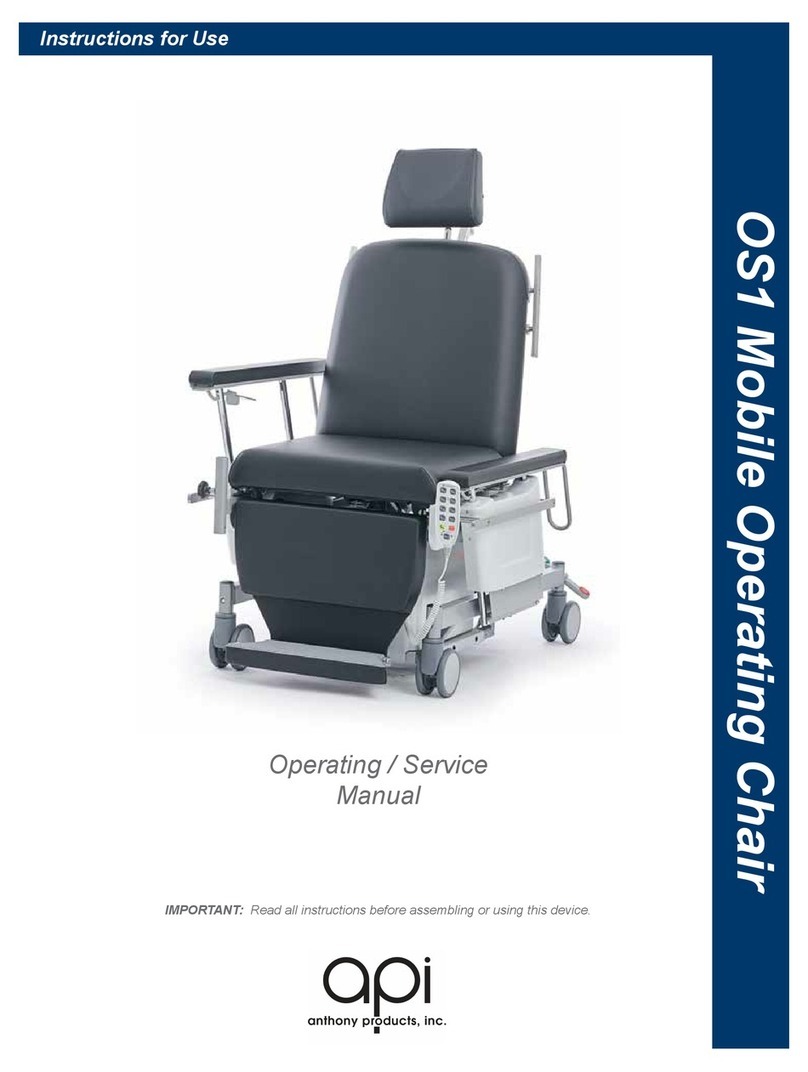
Jedmed
Jedmed api OS1 Service manual
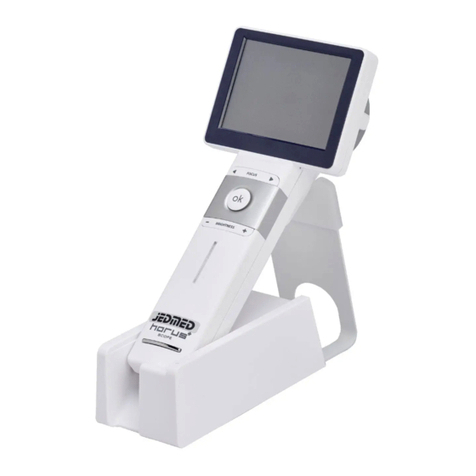
Jedmed
Jedmed Horus Scope 3 Series User manual

Jedmed
Jedmed Horus Scope User manual
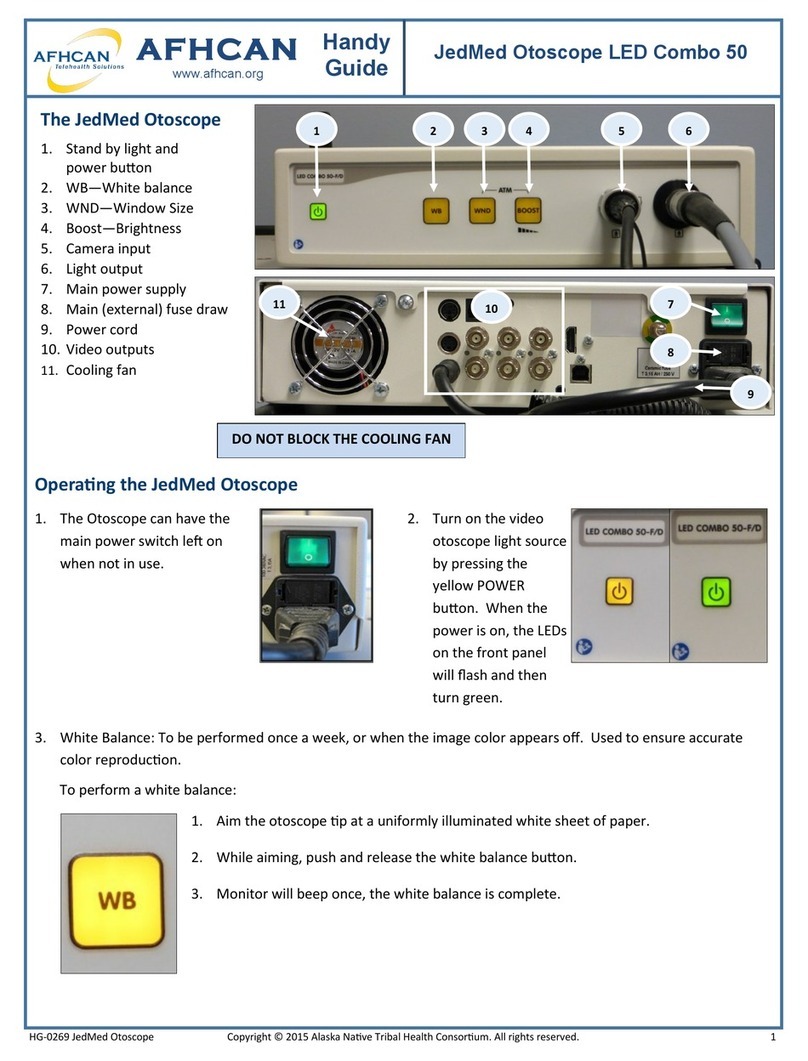
Jedmed
Jedmed Combo 50 User manual
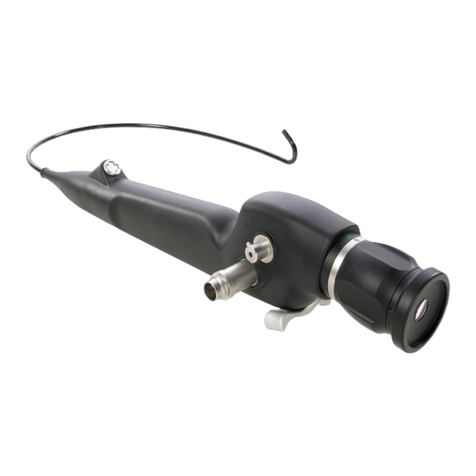
Jedmed
Jedmed Ergo-Flex User manual

Jedmed
Jedmed S-II Plus Instruction and safety manual
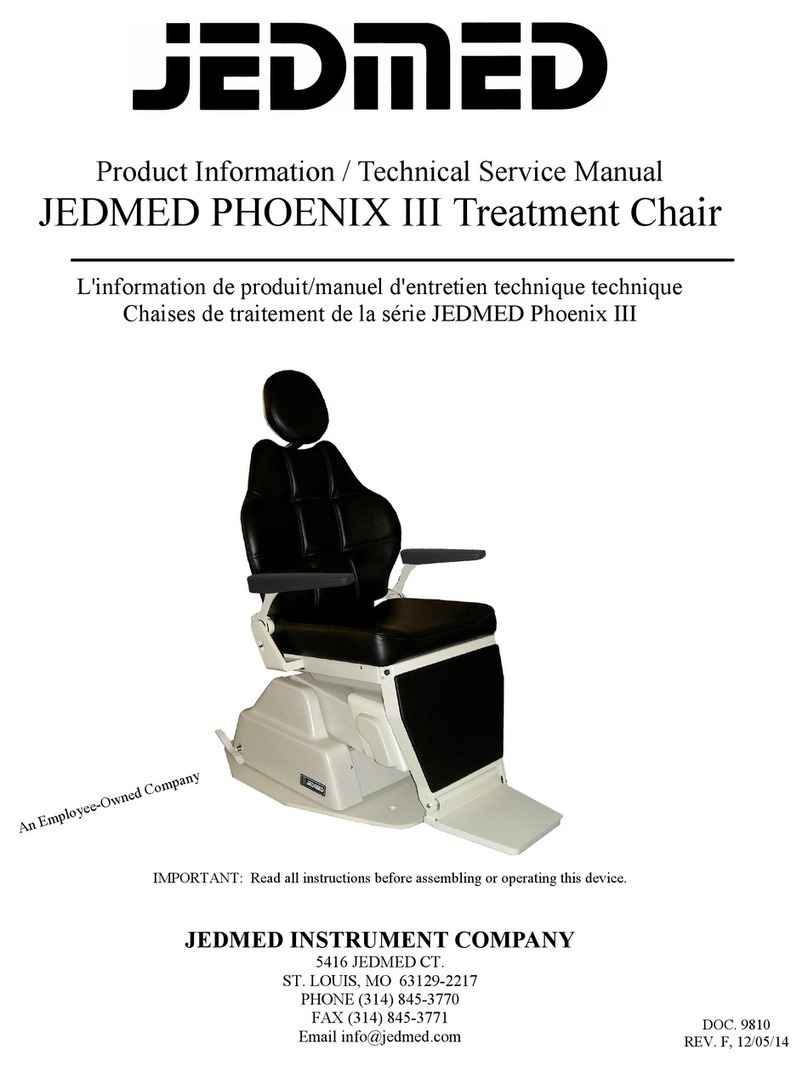
Jedmed
Jedmed PHOENIX III User manual
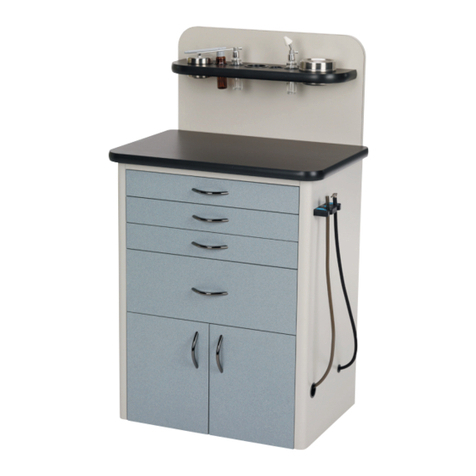
Jedmed
Jedmed Classic CSC ENT Instruction and safety manual
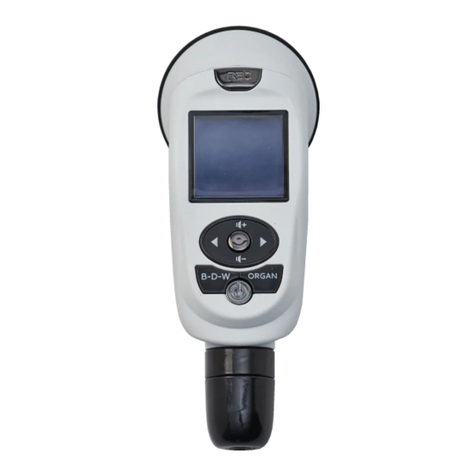
Jedmed
Jedmed Omni-Steth User manual
